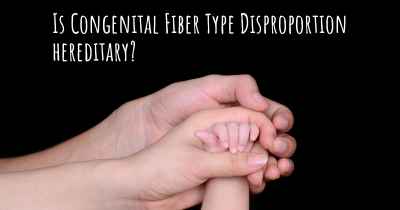What is the history of Congenital Fiber Type Disproportion?
When was Congenital Fiber Type Disproportion discovered? What is the story of this discovery? Was it coincidence or not?

Congenital Fiber Type Disproportion (CFTD):
Congenital Fiber Type Disproportion (CFTD) is a rare genetic muscle disorder that affects the structure and function of skeletal muscles. It is characterized by a significant size difference between two types of muscle fibers, namely type 1 (slow-twitch) and type 2 (fast-twitch) fibers. CFTD was first described in medical literature in the early 1960s, and since then, researchers have made significant progress in understanding its causes and clinical manifestations.
Discovery and Early Research:
The initial recognition of CFTD as a distinct disorder came from observations made by Dr. Victor Dubowitz, a British pediatric neurologist, in the early 1960s. He noticed that some children presented with muscle weakness and hypotonia (low muscle tone) but lacked the typical features of other muscle disorders. Dr. Dubowitz conducted muscle biopsies on these patients and identified the characteristic fiber size disproportion.
Genetic Basis:
Further research into CFTD revealed that it has a genetic basis. In the late 1990s, scientists discovered that mutations in the TPM3 gene, which encodes a protein called tropomyosin, were associated with CFTD. Tropomyosin is an essential component of the muscle contractile apparatus and plays a crucial role in muscle fiber development and function. Mutations in other genes, such as ACTA1 and SEPN1, have also been identified in some cases of CFTD.
Clinical Features:
CFTD primarily affects skeletal muscles, leading to muscle weakness and delayed motor milestones in affected individuals. The severity of symptoms can vary widely, ranging from mild muscle weakness to significant motor impairment. Infants with CFTD may have difficulty feeding and may exhibit respiratory problems due to weak respiratory muscles. Additionally, some individuals may experience joint contractures and scoliosis.
Diagnosis and Differential Diagnosis:
The diagnosis of CFTD is typically made through a combination of clinical evaluation, muscle biopsy, and genetic testing. Muscle biopsy remains an essential diagnostic tool as it allows for the identification of fiber size disproportion and other characteristic histological features. Genetic testing can confirm the presence of specific gene mutations associated with CFTD.
It is important to differentiate CFTD from other muscle disorders that may present with similar symptoms. This includes congenital myopathies, muscular dystrophies, and metabolic myopathies. A thorough evaluation by a multidisciplinary team of specialists, including neurologists and geneticists, is crucial for an accurate diagnosis.
Treatment and Management:
Currently, there is no cure for CFTD, and treatment focuses on managing the symptoms and improving quality of life. Physical therapy and occupational therapy play a crucial role in maintaining muscle strength and function. Assistive devices, such as braces or wheelchairs, may be necessary for individuals with significant motor impairment. Regular monitoring of respiratory function is essential to address any respiratory complications that may arise.
Research and Future Directions:
As CFTD is a rare disorder, research efforts have been limited. However, ongoing studies aim to further understand the underlying mechanisms of CFTD and explore potential therapeutic interventions. Gene therapy and pharmacological approaches are being investigated as potential treatment options. Additionally, advancements in genetic testing techniques have improved the ability to identify specific gene mutations associated with CFTD, allowing for more accurate diagnosis and genetic counseling.
In conclusion, Congenital Fiber Type Disproportion (CFTD) is a rare genetic muscle disorder characterized by a significant size difference between type 1 and type 2 muscle fibers. It was first described in the 1960s and has since been associated with mutations in genes such as TPM3, ACTA1, and SEPN1. Diagnosis involves clinical evaluation, muscle biopsy, and genetic testing. While there is no cure for CFTD, management focuses on symptom control and supportive care. Ongoing research aims to deepen our understanding of the disorder and explore potential treatment options.








